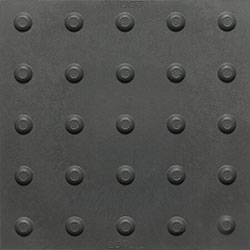









Installing compliant and durable detectable warning tiles is crucial for architects, contractors, and property owners to enhance accessibility in public spaces. But with a myriad of tile options available, choosing the right product tailored to your unique project requirements can get confusing.
This comprehensive guide provides expert insights to simplify the selection of appropriate detectable warning tiles based on factors like setting, traffic, longevity, costs, and aesthetics. Let’s explore how to pick ideal solutions to fulfill form and function.
Detectable warning tiles, also known as tactile walking surface indicators (TWSIs), are textured ground surface tiles that provide critical, non-visual navigation and hazard detection cues. Installed on pedestrian walkways, the tiles contain standardized textures like:
As per provincial accessibility legislation, integrating compliant detectable warning tiles is mandatory in public spaces to accommodate individuals with vision impairments or blindness.
With a wide variety of tile materials, textures, sizes, and installation formats available today, how do you pick the ideal options aligned to your project’s unique specifications?
Will the tiles be installed in exterior spaces exposed to weather or interior environments? Indoor options focus on fire ratings, noise reduction, and aesthetics. Rubber, stainless steel, composite polymers, and porcelain tiles suit interior spaces.
While outdoor spaces demand extra durability to withstand heavy foot traffic, UV radiation, moisture, freeze-thaw cycles, and abrasive agents like sand. Popular exterior tile materials are metals, porcelain, and engineered polymers.
Is this a new construction or retrofit project? For new builds, tiles can be directly embedded into fresh concrete to create a seamless finish. Access Tile and Armor Tile offer excellent cast-in-place detectable warning tiles.
For existing surfaces, self-adhesive surface-applied tiles are ideal for rapid upgrading. Access Tile, Eon Tile rubber tiles, Armor or Advantage Tactile stainless-steel plates suit surface-applying.
Footfall volume impacts longevity; for high-traffic zones like transit platforms, durable metal or porcelain tiles withstand decades of walking. Where occasional use is expected, composite polymer tiles suffice.
Certain tiles allow replacing only the damaged section instead of the entire installation. Access Tile Cast-In-Place and Cast-Iron replaceable Tactile Systems enable this. Other tiles require complete tile replacement. Assess long-term costs.
Composite polymer or rubber tiles offer more color/texture options to match surrounding finishes. Metals like stainless steel complement modern designs. Porcelain tiles provide upscale aesthetics for indoor lobbies.
Based on the above factors, here are some recommended compliant detectable warning tiles suitable for diverse public space projects:
Proper installation is vital for tiles to have optimal longevity and meet standards. Here are expert tile installation recommendations:
In Canada, detectable warning tiles must adhere to accessibility legislation and standards to ensure safety. Key regulations include:
By consulting these codes, you can select options that fulfill crucial compliance mandates around tile durability, detectability, dimensions, slip resistance, and placement in public spaces.
As Canada’s premier accessibility solutions provider, Tactile Solution Canada offers the widest selection of detectable warning tiles from trusted brands like Access Tile, Armor Tile, Advantage Tile, Eon Tile, and Elan Tile.
Engineered to be long-lasting, weather-resistant, and easy to install and replace, our tiles facilitate compliance with Canadian regulations like the AODA and CSA.
With in-house technical experts providing personalized recommendations, we simplify the selection of complaint tiles tailored to your unique specifications and setting.
Contact our team today for advice on finding suitable tactile warning tiles for your next public space project. Let us pave the path to universal accessibility and safety.
Key options are:
As per the regulations in Canada, locations like transit platforms, information kiosks, ticket counters, sidewalks, building entrances, curb ramps, stairs, and pedestrian crossings require compliant detectable warning tiles.
Based on setting and traffic, tiles may need replacement every 5-10 years. Durable options like metals and porcelain can last decades with minimal replacement needs.
The tiles provide standardized tactile and visual cues to help visually impaired individuals detect hazards, navigate safely, avoid disorientation, and travel independently.
Key considerations are the indoor vs. outdoor setting, expected traffic and loads, required longevity, ability to replace tiles, costs, required aesthetics, and applicable accessibility codes.
